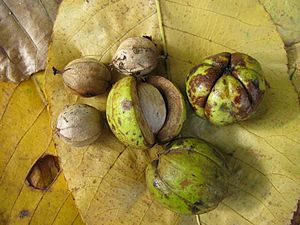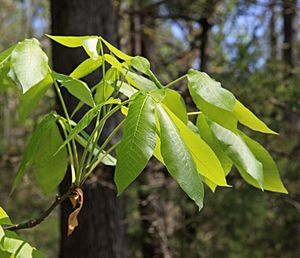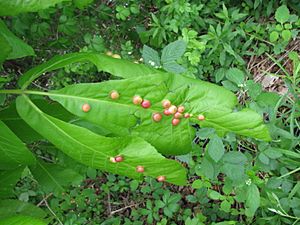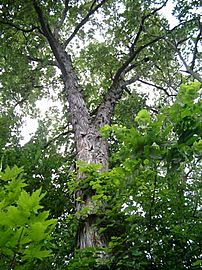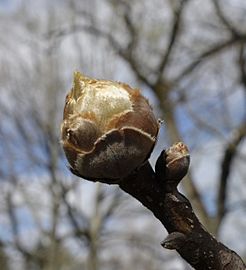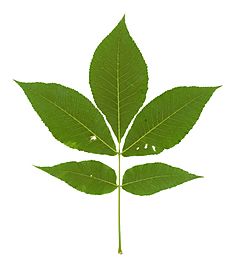Carya ovata facts for kids
Quick facts for kids Shagbark hickory |
|
|---|---|
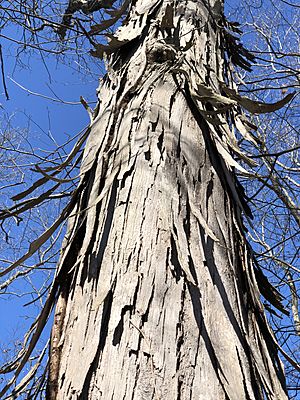 |
|
| Conservation status | |
| Scientific classification | |
| Genus: |
Carya
|
| Species: |
ovata
|
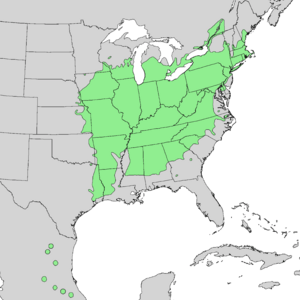 |
|
| Natural range of Carya ovata | |
The shagbark hickory (scientific name: Carya ovata) is a common hickory tree. You can find it in the Eastern United States and southeastern Canada. It is a very large deciduous tree, meaning its leaves fall off each autumn.
These trees can grow taller than 30 meters (100 feet). Some can even live for more than 350 years! The tallest shagbark ever measured was over 45 meters (150 feet) tall. It was found in Savage Gulf, Tennessee.
It's easy to spot a mature shagbark hickory. As its name suggests, it has bark that looks shaggy. This bark peels away in long strips. But remember, only older trees have this shaggy bark. Young shagbark trees have smooth bark.
The nuts of the shagbark hickory are safe to eat. They have a delicious, nutty taste. Many animals, and even people, enjoy them.
Contents
What Does a Shagbark Hickory Look Like?
The leaves of the shagbark hickory are about 30 to 60 centimeters (12 to 24 inches) long. Each leaf has five leaflets, but sometimes it can have three or seven. The three leaflets at the end of the leaf are much bigger than the two at the base.
Flowers and Fruit
Shagbark hickory trees have both male and female flowers on the same tree. This is called being monoecious. The male flowers grow on long, hanging clusters called catkins. These appear at the tips of old branches.
The female flowers grow in short spikes at the ends of new branches. After the flowers, the tree produces fruit. This fruit is a drupe, which is a fleshy fruit with a hard pit inside.
The fruit is about 2.5 to 4.0 centimeters (1 to 1.5 inches) long. It has a thick, green husk with four sections. This husk turns dark and splits open in the fall when the nut is ready. Inside is an edible nut with a very hard shell.
The buds at the very end of the branches are large. They are covered with loose scales.
Types of Shagbark Hickory
There are two main types, or varieties, of shagbark hickory:
- Carya ovata var. ovata: This is the northern shagbark hickory. Its largest leaflets are usually over 20 centimeters (8 inches) long. Its nuts are about 3.0 to 4.0 centimeters (1.2 to 1.5 inches) long.
- Carya ovata var. australis: This is the southern shagbark hickory, also called Carolina hickory. Its largest leaflets are usually under 20 centimeters (8 inches) long. Its nuts are about 2.5 to 3.0 centimeters (1 to 1.2 inches) long.
Some experts think the southern shagbark hickory might be a completely separate species.
Where Do Shagbark Hickories Grow?
Shagbark hickory trees are found across most of the eastern United States. However, they are not common in the very southeastern coastal areas. They are also rare in the lower Mississippi Delta regions.
You can find a small group of these trees in eastern Canada. They grow as far north as Lavant Township. There are also some scattered shagbark hickories in the Sierra Madre Oriental mountains of eastern Mexico.
Shagbark hickory trees were brought to Europe in the 1600s. You can still find them there today, but they are not native to Europe.
How People and Animals Use Shagbark Hickory
The nuts of the shagbark hickory are very tasty. They are a favorite food for both people and animals like squirrels.
Nuts as Food
Native Americans, such as the Algonquins, used hickory nuts as an important food source. They would make a "nut milk" from the kernels. This milk was used to make corn cakes and other dishes.
Many animals also love hickory nuts. These include red squirrels, gray squirrels, raccoons, chipmunks, and mice. Other animals that eat them are black bears, foxes, rabbits, and birds like mallards, wood ducks, bobwhites, and wild turkeys.
Shagbark hickory trees start making seeds when they are about 10 years old. But they don't produce many nuts until they are about 40 years old. They can continue to produce nuts for at least 100 years. However, the amount of nuts they produce can change a lot each year. They might have a big crop every 3 to 5 years, and then very few or no nuts in between. Animals can also eat all the nuts.
Wood and Bark Uses
The wood of the shagbark hickory is very strong and tough. It is also heavy. Because of its strength, it has been used for many tools and parts that need to be durable. This includes axe handles, parts for plows, skis, and drum sticks.
Native Americans in northern areas used shagbark hickory wood to make bows. The wood is also used for smoking meat, which gives the meat a special flavor.
The bark of the shagbark hickory can even be used to flavor a syrup that tastes like maple.
Shagbark Hickory in History
Andrew Jackson, who was the seventh president of the United States, had a nickname: "Old Hickory." This nickname came from how tough and strong hickory wood is.
In 1830, President Jackson began planning his tomb at his home, The Hermitage, in Tennessee. The grave site was surrounded by many trees, including six large shagbark hickories. These trees stood there for 168 years. But in 1998, a big storm knocked down over 1,200 trees at The Hermitage, including the old hickories. People are still working to replant trees there today.
Today, shagbark hickory trees are not often planted in gardens or parks. This is because they grow very large and slowly. Also, they are hard to move once they start growing because they have a deep main root. And, of course, they drop many nuts.
Genetics of Shagbark Hickory
Shagbark hickory trees can sometimes mix with other hickory species. They can create hybrid trees with pecan trees and shellbark hickory trees. These mixed trees are sometimes called "hicans."
Shagbark hickory trees have 32 chromosomes. Trees within the same group that have the same number of chromosomes can usually cross-breed. Many different hybrids have been found among hickory species with 32 chromosomes. These include pecan, bitternut, shellbark, and shagbark. Most of these hybrids are not very productive, but a few "hican" types are grown for their nuts.
Gallery
See also
 In Spanish: Jicoria ovada para niños
In Spanish: Jicoria ovada para niños



